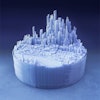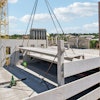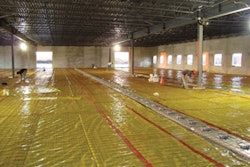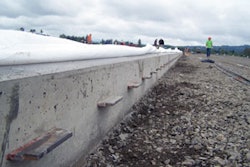When someone says flooring materials have failed, where is the blame placed? Increasingly, the concrete slab stands accused, which means accusations against the supplier and the contractor. Never mind that they rarely are involved in developing the specifications for concrete. They mix and install it to the specifications given to them. Yet, in defect litigation, the finger of blame increasingly points at them.
While this is particularly common in California, it may come to your town, too, given the proliferation of flooring standards that cite nationally established and published requirements that appear to govern concrete substrates to which flooring is applied. In this two-part series, I will outline the situation and suggest a plan of action to meet this challenge.
As litigation concerning building construction has flourished, the relevance of and reliance on consensus standards for building construction has grown. Though there have been incremental technical and procedural changes in cement and concrete standards over the years, the standards developed and universally adopted by these industries have been proven effective. Not so with flooring "standards."
As flooring standards are increasingly recognized as authoritative, especially in legal proceedings, and as flooring problems have escalated in recent decades, many people have applied flooring standards to concrete construction. Even when little scientific evidence supports it.
For instance, ASTM F710, "Standard Practice for Preparing Concrete Floors to Receive Resilient Flooring," was published in 1981. Since then, revisions were published by members of the Resilient Floor Covering Committee. In defect litigation, attorneys may attempt to apply this flooring standard to residential and commercial concrete construction.
For example, F710 Appendixes, Part X1.2, concerning water-cement ratio states: "Moderate to moderately low water-cement ratios (0.40 to 0.45) can be used to produce floor slabs that can be easily placed, finished, and dried, and which have acceptable permeability to moisture. Floor slabs with water-cement ratios above 0.60 take an exceedingly long time to dry and cause adhesives or floor coverings, or both, to fail due to high moisture permeability." Additional topics covered by F710 include concrete strength, pH levels and somewhat random comments about flatness, curing, drying, new floors, radiant-heated concrete slabs, sulfate attack in California and efflorescence.
My review of F710 suggests that it contains incorrect, incomplete and contradictory statements. Nonetheless, ASTM F710 has come to influence litigation concerning concrete slabs because it appears to substantiate arguments that the concrete in question is somehow defective.
Unfortunately, the concrete industry did not anticipate the diverse ways in which F710 would enter standards territories that, in my opinion, should be the sole jurisdiction of ACI's writings or those of ASTM Committees C-1 (Cement) and C-9 (Concrete). Unless the concrete industry becomes proactive and engages in the standards-writing and standards-correcting process of the industries encroaching upon it, concrete contractors and suppliers will find it more difficult, and ever more expensive, to mount a successful defense and refute liability in defect litigation.
Recently I served as an expert in two defective single-family residential cases in which the plaintiffs' wood flooring was damaged. Experts in both cases asserted that water caused the damage by penetrating the slab from below.
In one case, the plaintiffs alleged the flooring installers had failed to conduct the "required" moisture vapor emissions tests, that the installers had not confirmed the suitability of the concrete slab to receive the wood flooring, and, therefore, were liable.
In the second case, the attorney defending a concrete contractor asserted that 30-year-old interior slabs and foundations were defective. This defense shifted the blame from his client, who had improperly installed concrete sidewalks and a patio, resulting in water intrusion into the house. His experts claimed that moisture had passed from the soils below and through the slab, warping the flooring.
In fact, the diagnosis was obvious in both cases - poor drainage, ponding adjacent to the structures, and water intrusion through doorways from rainfall and landscape irrigation led to water-damaged flooring. Neither of these determinations required vapor emission testing or legislation mandating tests on interior concrete slabs. Yet we had to refute allegations of excessive moisture in the slabs because of the generally illogical notion that moisture, defying gravity, regularly flows up from the soils, into and through the slab, to harm the flooring.
In the first case, the defendant prevailed after a lengthy and expensive jury trial; both plaintiff and defendant now face bankruptcy. In the second case, the defendant was found liable, exonerating the interior concrete slab.
The underlying challenge is that when judges or laws recognize flooring industry standards that reference concrete, it is increasingly hostile to you as a concrete contractor, supplier or designer because flooring standards that define "acceptable" slabs have been adopted by standards writers with little legitimate basis.
Part 2 will address the fundamental problems of flooring standards and recommend steps for counteracting this growing threat to the concrete industry.













![Fcp Racatac Chair 10893876[1]](https://img.forconstructionpros.com/mindful/acbm/workspaces/default/uploads/2025/10/fcp-racatac-chair-108938761.10l0At5WXv.png?ar=16%3A9&auto=format%2Ccompress&bg=fff&fill-color=fff&fit=fill&h=135&q=70&w=240)





